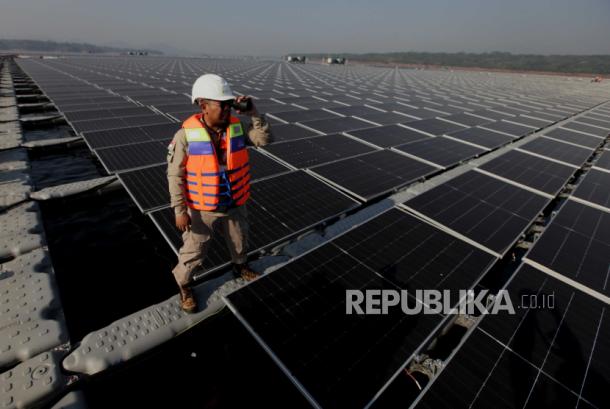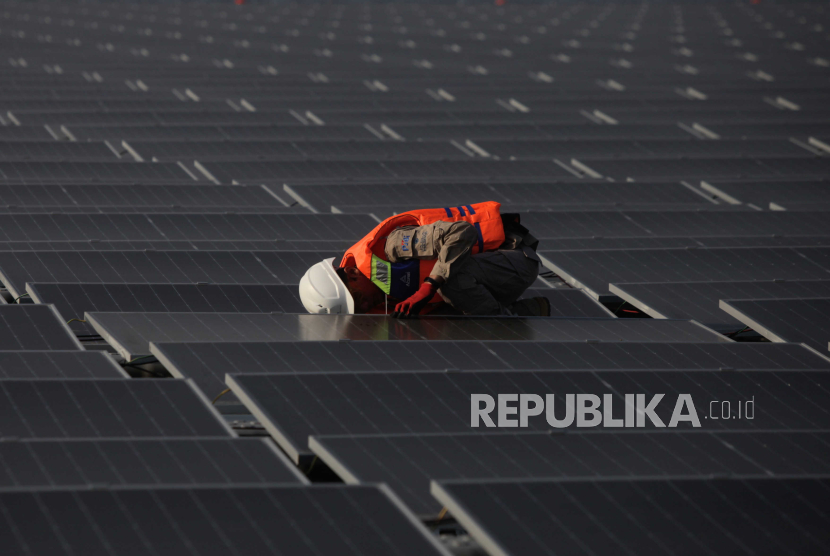JAKARTA — The government will accelerate the construction of solar power plants (PLTS), including floating power plants. After the project to build a floating power plant in Cirata, West Java, was completed, the Ministry of Energy and Mineral Resources (ESDM) said it would replicate floating power plants in several other locations in Indonesia.
PLTS will be one of the mainstays of the government in making the energy transition. Director General of New Energy, Renewables, and Energy Conservation (EBTKE) of the Ministry of ESDM Yudo Dwinanda Priaadi revealed that the potential of floating hydroelectric power plants on lakes and other dams in Indonesia reaches 89.36 GW in 295 locations.
Of the total potential floating power plants, it consists of floating hydroelectric power plants in lakes totaling 74.67 GW in 36 locations and floating hydroelectric power plants in dams totaling 14.7 GW in 259 locations.
“What we need to do next is replicate this (floating power plant) and we will be scaling up with so many potential reservoirs in Indonesia, given that the government has been actively building reservoirs and dams lately,” Yudo said in a statement on Friday (10/11/2023).
In the next few years, Yudo added, there will be two floating power plants that will also operate, namely Saguling and Singkarak floating power plants. “The nearest one is now Saguling, the first dam of the Citarum River cascade, and the other Singkarak, that's the closest,” he said.
Based on PT PLN's Electricity Supply Business Plan (RUPTL) 2021-2030, Saguling Floating Power Plant in West Java will have a capacity of 60 MW, while Singkarak Floating PTLS in West Sumatra will have a capacity of 48 MW.
In addition, based on RUPTL, there will still be five Floating Power Plants to be built until 2030, namely in Wonogiri Reservoir, Central Java, with 100 MW, Sutami Reservoir, East Java, with 122 MW, Jatiluhur Reservoir, West Java, with 100 MW, Mrica Reservoir, West Java, 60 MW, and Wonorejo Reservoir, East Java, 122 MW.
Minister of ESDM Arifin Tasrif said that Cirata Floating Power Plant is a showcase for accelerating energy transition in support of achieving net zero emissions (NZE). The power plant will contribute 245 GWh per year to the NZE and reduce emissions by 214 thousand tons per year.
“The capacity of the Cirata Floating Power Plant can still be developed even larger, with the total maximum potential reaching about 1.2 GWp if using 20 percent of the total area of the Cirata Reservoir,” Arifin said on Thursday (9/11/2023).
Arifin said that the development of this large-scale solar PV plant could be an attraction for the industry to make solar PV raw materials. “Hopefully, in the future raw materials can be developed in Indonesia so that the TKDN can be full,” he said.
Cirata Floating Power Plant is the result of a collaboration between two countries, namely Indonesia and the United Arab Emirates (UAE), involving the subholding of PLN Nusantara Power with Masdar from the UAE. To promote the development of floating power plants in Indonesia, all parties need to work in synergy. Cooperation with international partners is essential to open access to clean energy funding and proven technology.
The presence of a large-scale floating power plant in Indonesia is expected to increase investor confidence and encourage technological innovation as a solution to land limitations in solar energy development, where Indonesia has a huge potential for floating power plants.
Cirata Floating Power Plant can also be an example in optimizing the potential of floating power plants on reservoirs and other dams in Indonesia, with a potential of 89.36 GW in 295 locations. Of the total potential floating power plants, it consists of floating hydroelectric power plants in lakes totaling 74.67 GW in 36 locations and floating hydroelectric power plants in dams totaling 14.7 GW in 259 locations.

Whereas, the hydropower potential in the dam was recorded at 567.4 MW consisting of 557.3 MW (59 dams) listed in the RUPTL 2021-2030 and 10.8 MW (8 dams) outside the RUPTL. In addition, there is also a plan to build pump storage of 4.2 GW by 2030
In its work, the Cirata Floating Power Plant project involved workers from the surrounding residents as many as 1,400 workers from the local communities around the project and the surrounding MSMEs. In addition, through high-tech innovations it is able to overcome challenging reservoir depths of 80-100 meters, slope of 5-20 degrees, variation of reservoir water elevation level up to 15 meters, and use of special design for anchoring and mooring with muddy reservoir bottom.
On the tariff side, Cirata's highly competitive Floating Power Plant tariff of USD 5.8 cent/kWh is expected to lower the basic cost of supply (BPP) of electric power and make PLN more self-sufficient and reduce reliance on subsidies/compensation. The plant also helps communities get greener electricity supplies. In fact, it can open up opportunities for people to participate in the development of green energy both with Renewable Energy Certificates (REC) and carbon trading.


